Abstract
Charge-pulse experiments were performed in the presence of structural analogues of tetraphenylborate (TPB) on membranes made of dioleoyl phosphatidylethanolamine and dioleoyl phosphatidylcholine. The analysis of the experimental results using a previously proposed model allowed the calculation of the partition coefficient, beta, and of the translocation rate constant, kappa i. The temperature dependence of the partition coefficients was used to calculate the thermodynamics of the adsorption of the lipophilic ions to the membranes. The analysis of the translocation rate constants obtained at different temperatures yielded detailed information on the free energy of the TPB-analogues within artificial lipid bilayer membranes, and on the activation energy of the translocation rate constants. The adsorption of the different TPB-analogues to the membranes was only slightly affected by their structure, whereas a dramatic influence of the structure on the free energy of the lipophilic ions within the membranes was observed. The free energy of the ions in the membranes decreased from triphenylcyanoborate (TPCB) to tetrakis(3-trifluoromethylphenyl)borate (TTFPB) by more than 31 kJ/mol (7.4 kcal/mol). This could be concluded from the observed increase in the translocation rate constant by almost six orders of magnitude. The change of the free energy in the membrane was used for the estimation of an effective radius of the TPB-analogues with respect to TPB.
Full text
PDF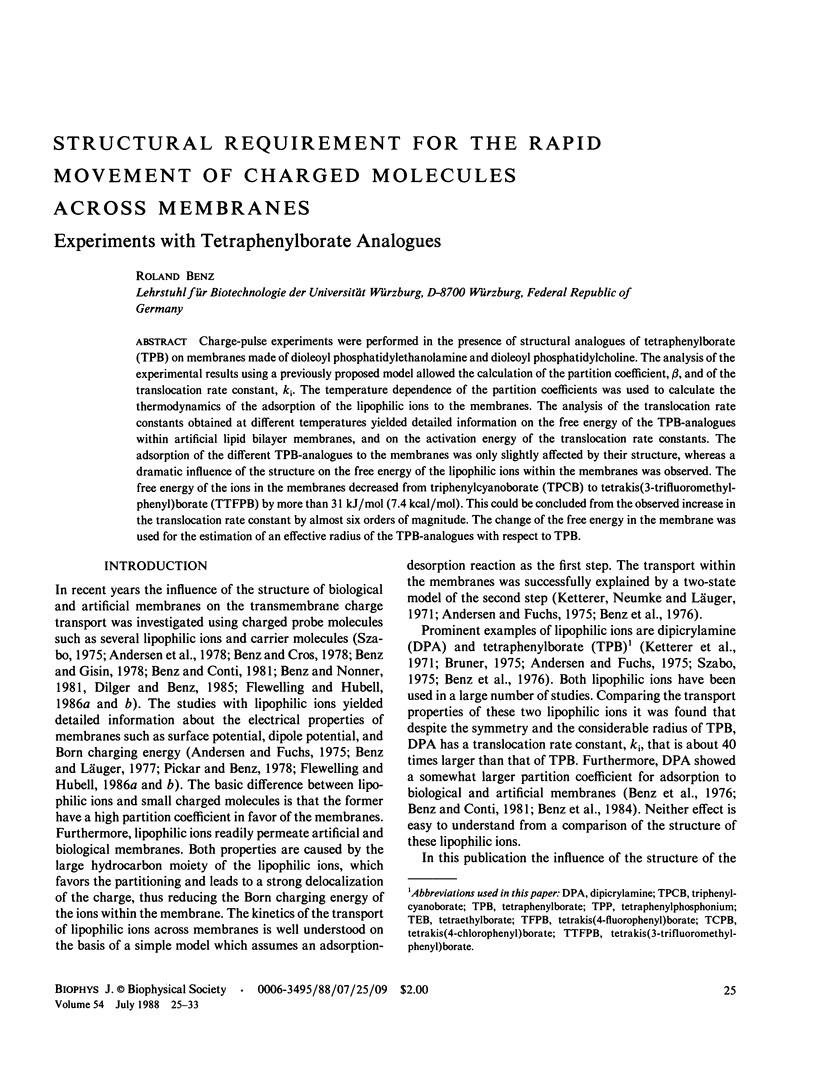

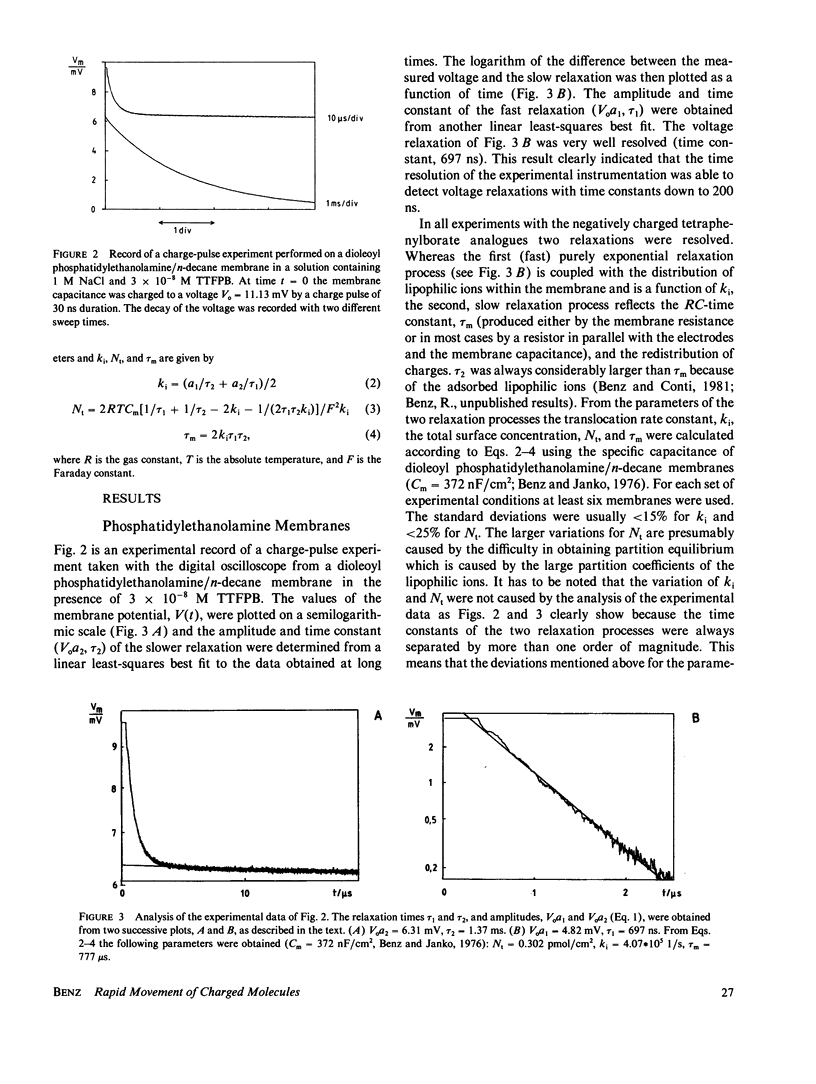
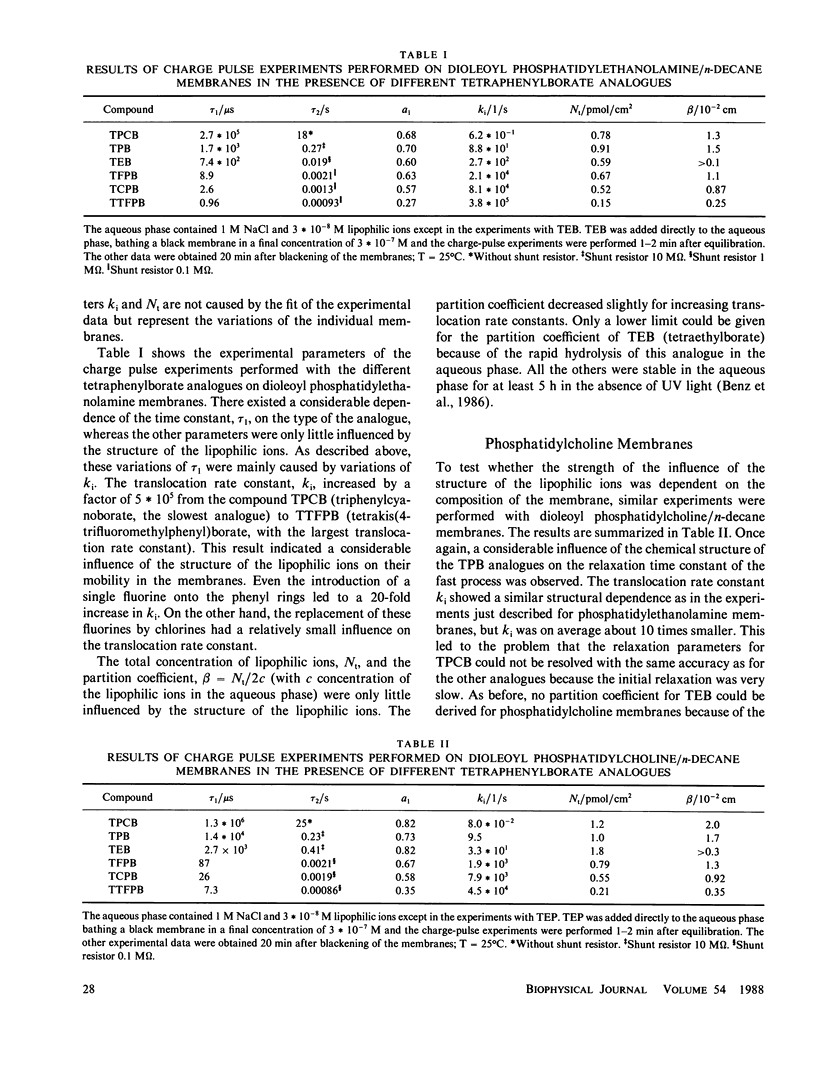

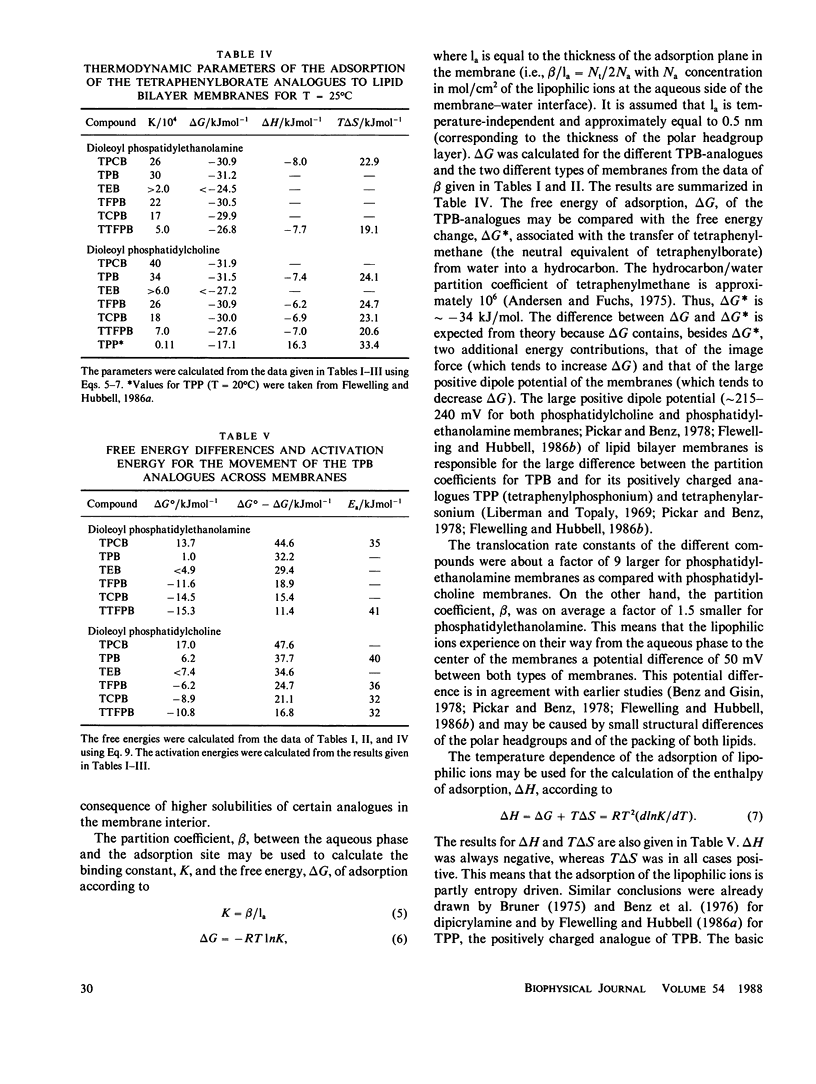

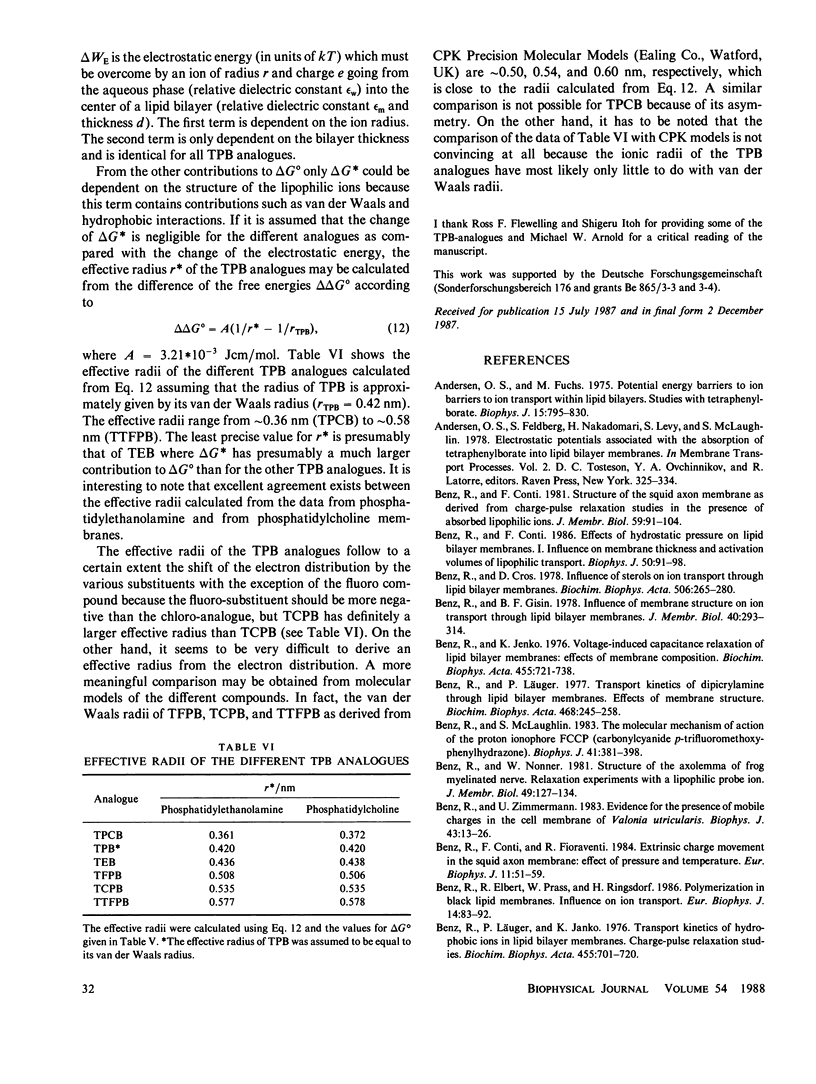
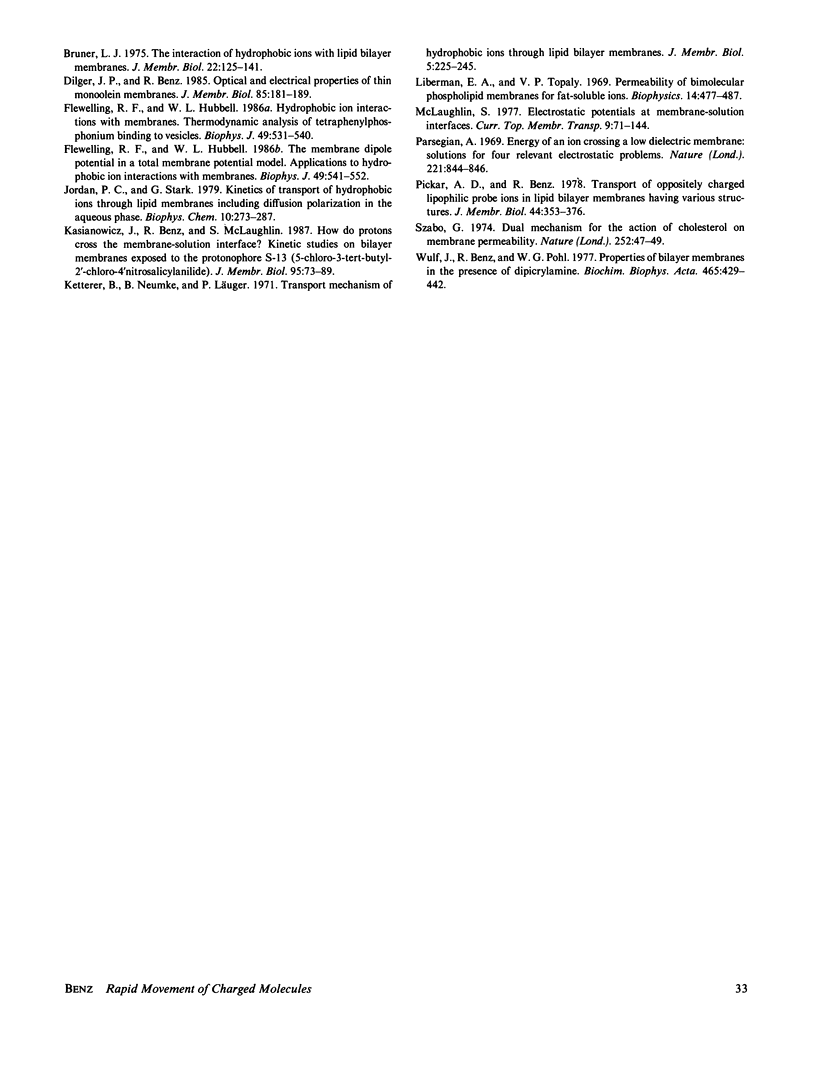
Selected References
These references are in PubMed. This may not be the complete list of references from this article.
- Andersen O. S., Fuchs M. Potential energy barriers to ion transport within lipid bilayers. Studies with tetraphenylborate. Biophys J. 1975 Aug;15(8):795–830. doi: 10.1016/S0006-3495(75)85856-5. [DOI] [PMC free article] [PubMed] [Google Scholar]
- Benz R., Conti F. Effects of hydrostatic pressure on lipid bilayer membranes. I. Influence on membrane thickness and activation volumes of lipophilic ion transport. Biophys J. 1986 Jul;50(1):91–98. doi: 10.1016/S0006-3495(86)83442-7. [DOI] [PMC free article] [PubMed] [Google Scholar]
- Benz R., Conti F., Fioravanti R. Extrinsic charge movement in the squid axon membrane. Effect of pressure and temperature. Eur Biophys J. 1984;11(1):51–59. doi: 10.1007/BF00253858. [DOI] [PubMed] [Google Scholar]
- Benz R., Conti F. Structure of the squid axon membrane as derived from charge-pulse relaxation studies in the presence of absorbed lipophilic ions. J Membr Biol. 1981 Apr 15;59(2):91–104. doi: 10.1007/BF01875707. [DOI] [PubMed] [Google Scholar]
- Benz R., Cros D. Influence of sterols on ion transport through lipid bilayer membranes. Biochim Biophys Acta. 1978 Jan 19;506(2):265–280. doi: 10.1016/0005-2736(78)90397-8. [DOI] [PubMed] [Google Scholar]
- Benz R., Gisin B. F. Influence of membrane structure on ion transport through lipid bilayer membranes. J Membr Biol. 1978 Jun 9;40(4):293–314. doi: 10.1007/BF01874161. [DOI] [PubMed] [Google Scholar]
- Benz R., Janko K. Voltage-induce capacitance relaxation of lipid bilayer membranes. Effects of membrane composition. Biochim Biophys Acta. 1976 Dec 14;455(3):721–738. doi: 10.1016/0005-2736(76)90043-2. [DOI] [PubMed] [Google Scholar]
- Benz R., Läuger P., Janko K. Transport kinetics of hydrophobic ions in lipid bilayer membranes. Charge-pulse relaxation studies. Biochim Biophys Acta. 1976 Dec 14;455(3):701–720. doi: 10.1016/0005-2736(76)90042-0. [DOI] [PubMed] [Google Scholar]
- Benz R., Läuger P. Transport kinetics of dipicrylamine through lipid bilayer membranes. Effects of membrane structure. Biochim Biophys Acta. 1977 Jul 14;468(2):245–258. doi: 10.1016/0005-2736(77)90118-3. [DOI] [PubMed] [Google Scholar]
- Benz R., McLaughlin S. The molecular mechanism of action of the proton ionophore FCCP (carbonylcyanide p-trifluoromethoxyphenylhydrazone). Biophys J. 1983 Mar;41(3):381–398. doi: 10.1016/S0006-3495(83)84449-X. [DOI] [PMC free article] [PubMed] [Google Scholar]
- Benz R., Nonner W. Structure of the axolemma of frog myelinated nerve: relaxation experiments with a lipophilic probe ion. J Membr Biol. 1981 Apr 15;59(2):127–134. doi: 10.1007/BF01875710. [DOI] [PubMed] [Google Scholar]
- Benz R., Zimmermann U. Evidence for the presence of mobile charges in the cell membrane of Valonia utricularis. Biophys J. 1983 Jul;43(1):13–26. doi: 10.1016/S0006-3495(83)84318-5. [DOI] [PMC free article] [PubMed] [Google Scholar]
- Bruner L. J. The interaction of hydrophobic ions with lipid bilayer membranes. J Membr Biol. 1975;22(2):125–141. doi: 10.1007/BF01868167. [DOI] [PubMed] [Google Scholar]
- Dilger J. P., Benz R. Optical and electrical properties of thin monoolein lipid bilayers. J Membr Biol. 1985;85(2):181–189. doi: 10.1007/BF01871270. [DOI] [PubMed] [Google Scholar]
- Flewelling R. F., Hubbell W. L. Hydrophobic ion interactions with membranes. Thermodynamic analysis of tetraphenylphosphonium binding to vesicles. Biophys J. 1986 Feb;49(2):531–540. doi: 10.1016/S0006-3495(86)83663-3. [DOI] [PMC free article] [PubMed] [Google Scholar]
- Flewelling R. F., Hubbell W. L. The membrane dipole potential in a total membrane potential model. Applications to hydrophobic ion interactions with membranes. Biophys J. 1986 Feb;49(2):541–552. doi: 10.1016/S0006-3495(86)83664-5. [DOI] [PMC free article] [PubMed] [Google Scholar]
- Jordan P. C., Stark G. Kinetics of transport of hydrophobic ions through lipid membranes including diffusion polarization in the aqueous phase. Biophys Chem. 1979 Nov;10(3-4):273–287. doi: 10.1016/0301-4622(79)85016-4. [DOI] [PubMed] [Google Scholar]
- Kasianowicz J., Benz R., McLaughlin S. How do protons cross the membrane-solution interface? Kinetic studies on bilayer membranes exposed to the protonophore S-13 (5-chloro-3-tert-butyl-2'-chloro-4' nitrosalicylanilide). J Membr Biol. 1987;95(1):73–89. doi: 10.1007/BF01869632. [DOI] [PubMed] [Google Scholar]
- Parsegian A. Energy of an ion crossing a low dielectric membrane: solutions to four relevant electrostatic problems. Nature. 1969 Mar 1;221(5183):844–846. doi: 10.1038/221844a0. [DOI] [PubMed] [Google Scholar]
- Szabo G. Dual mechanism for the action of cholesterol on membrane permeability. Nature. 1974 Nov 1;252(5478):47–49. doi: 10.1038/252047a0. [DOI] [PubMed] [Google Scholar]
- Wulf J., Benz R., Pohl W. G. Properties of bilayer membranes in the presence of dipicrylamine. A comparative study by optical absorption and electrical relaxation measurements. Biochim Biophys Acta. 1977 Mar 17;465(3):429–442. doi: 10.1016/0005-2736(77)90262-0. [DOI] [PubMed] [Google Scholar]


